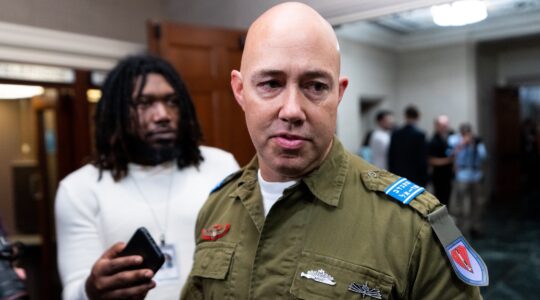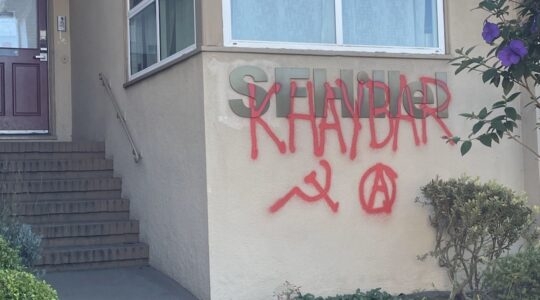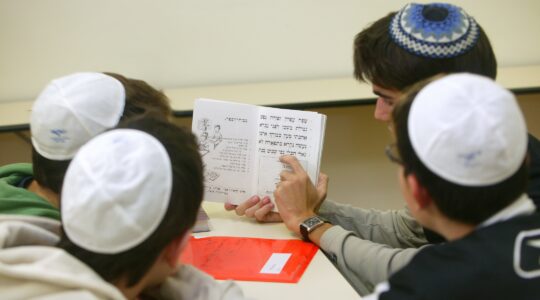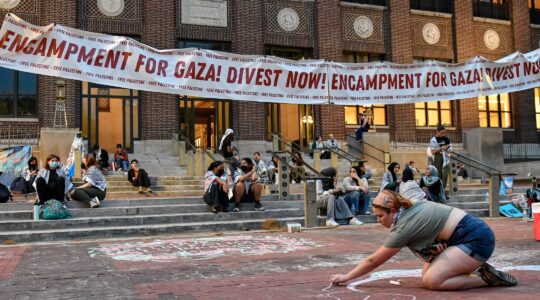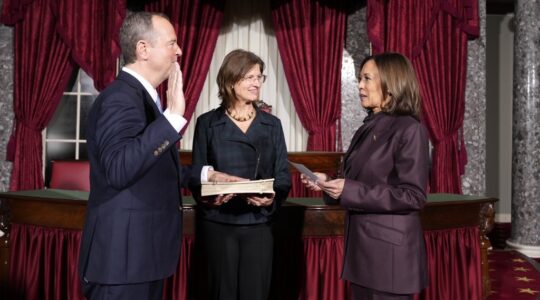NEW ORLEANS (JTA) – Lifelong New Orleans resident Alan Smason has been chronicling his experience during Hurricane Gustav on his blog, KosherComputing. Below are excerpts from his reporting, including descriptions of how the city’s Jewish community has responded to the storm.
Aug. 27, 2008:
It looks like my worst fears have been realized. A storm with the potential to be worse than Hurricane Katrina seems destined to impact New Orleans. I am frightened, but I am determined to stay and report on this very important event. I am thinking that I should be hoofing it right about now, but I know that my true responsibility is to let people know what is happening here. I have the resources to do so and will be dumb enough to be prepared to hunker down and deal with this natural disaster.
Don’t misunderstand me. I am sure that I will be dealing with a loss of power at the very least. However, if things work out, I will be at the epicenter of a very important story. Say a prayer for me and wish me well.
Aug. 29:
Three years ago the city of New Orleans withstood its greatest challenge when Hurricane Katrina slammed into it with wind gusts of up to 140 miles per hour. What followed the onslaught of wind and driving rain was a man-made disaster of greater proportions, the failure of the levee structures designed to protect the city. It has taken an army of dedicated city workers, loyal residents and outsiders who won’t stand idly by and let politics and apathy take over where the flood waters receded. The only thing that can kill the city of New Orleans is not opposition to its rebuilding campaign; it is apathy. Apathy will drive a wedge into the heart and soul of the City That Care Forgot. So on this important anniversary, as another storm threatens her, don’t you forget to care.
Aug. 30:
Mayor Ray Nagin just announced the second mandatory evacuation for New Orleans this evening just before 8 p.m. Gov. Bobby Jindal and Lt. Gov. Mitch Landrieu has also urged everyone to take heed to the warnings and get out of town now. We are on the bad side of the expected track of the storm, even more so than Hurricane Katrina.
The exodus out of the city has been going on all day with most every channel out of the city slogged down to a snail’s pace at the edge of the city. All Home Depot, Lowe’s, Wal-Mart, and Sam’s Club stores have closed down as of yesterday. Gas stations have shuttered their doors and most essential services are but a memory.
I have resigned myself to the fact that this is a life-threatening situation. Family members have all called and urged me to get out. Yet I believe it is necessary that someone be here to document what is happening here as we prepare for the worst and hope for he best.
Thursday evening’s Levees.org event had an auditorium full of people at Touro Synagogue, but that was before the dire warnings from authorities began to be issued. Friday afternoon a Mincha (afternoon) prayer service was held at the Lakeview site of Congregation Beth Israel. That structure is still shuttered after three years following catastrophic destruction that resulted after the 17th Street Canal levee was breached during Hurricane Katrina.
After the service was over, the members headed over to Congregation Gates of Prayer in Metairie, the site where they are now meeting to hold Shabbat services and to enjoy a meal with one another into the late hours of the night. At the same time across town at Temple Sinai, one of the oldest Reform temples in New Orleans, an interfaith prayer service hosted by Rabbi Ed Paul Cohn was held. At the event was Francis Hughes, Archbishop of the City of New Orleans; Episcopal Bishop Charles Jenkins; as well as other clergy representing Protestant, the Ba’hai and Islamic faith groups. It was an impressive night. Yet, the storm that was forming in the Caribbean was very much on people’s minds. It was the elephant in the back of the room that could not be ignored.
Aug. 31:
I am watching the last of my neighbors pack up his truck as he prepares to hit the road with his family headed for Texas. Our normally busy street is deserted. The stillness in the air is pierced by gusts of what is now a very pleasant breeze. In just a few more hours, however, it will be another story.
Gustav is intent on making me a very unpleasant camper and I have horrible feelings about having to leave my humble abode, the home I had been forced to desert unintentionally after the levee breaches three years ago. It has only been 16 months since I returned to New Orleans, living 20-plus months in Cleveland, Ohio. The prospect of having to stay away for another undetermined period is frightening and heartbreaking.
What effect this storm will have on the ongoing recovery effort from Katrina remains to be determined. Certainly the effect on the psyche of the populace has been severe.
The only good news is that Gustav seems to be intensifying less than expected and that it still seems to be on a track headed away from New Orleans. It’s just not far enough. Were I in Mobile, Ala. – a two hour’s drive under normal conditions – I would still be in peril. So the best thing to do is head north and hope that the levees hold.
Sept. 1:
There is no doubt that with the mandatory evacuations of both Orleans and Jefferson parishes, the greatest confluence of members of the extended New Orleans Jewish community is right here at Henry S. Jacobs Camp in Utica, Miss. Worried evacuees have been crowding into the recreation hall at the camp this morning where a large screen rear projection TV with stereo speakers has been broadcasting WDSU’s signal over DirectTV’s Channel 361.
WDSU has always been my favorite New Orleans station. After all, it was the area’s first television station, founded in 1948 by Edgar Stern, one of the Jewish community’s best-known philanthropists.
According to reports, news from the city is good this morning. Gustav has been downgraded from a Category 3 storm to a Category 2. My good friends in Houma are taking the full force of the storm, but it has proven to be a lot less of a “mother of all storms” and more like a kid sister. There is concern still left for St. Bernard and Plaquemines parishes because of rising water and the possibility that levees could be topped. Gustav is still a very dangerous storm and the levees will continue to be tested for another 12 hours. Yet as was the case with Katrina, it could have been so much worse.
So the waiting game goes on here in Mississippi, but I believe we may have dodged a bullet.
I left New Orleans at 7:05 p.m., just as the first droplets of rain began to fall and the most ominous clouds you can imagine began to peer over the horizon. All day long the breeze was steady, but really only gusting every now and then.
Just as my car was finally packed and I was ready to leave for Henry S. Jacobs Camp, the wind started to pick up significantly. The air became crisp and cold, and the skies darkened. Once I started winding my way onto the streets adjacent to my home, the heavens opened and the heavy rain was a more or less constant companion for me until on the interstate well into Mississippi. At times the rain was driven horizontally towards my windshield by the sheer force of the winds. It was scary but manageable.
That was the bad news. The good news was that since I waited so long to leave, there was very little traffic on the highway. What I had surmised would be a five- or six-hour ordeal turned out to be a little over three hours, more or less normal driving time between New Orleans and the camp, which also serves as the site of the Museum of the Southern Jewish Experience, whose executive director Macy Hart was the original director of Henry S. Jacobs Camp 40 years ago.
There are about 150 Jewish New Orleanians living at Jacobs camp for the next few days (they hope no more than that). Although donations are being accepted, the camp’s present director, Jonathan Cohen, is not charging for any essential services for any visitors. The camp is charging for meals. Nevertheless it is still a remarkable gift of charity.
Meanwhile, the Jewish Federation of Greater New Orleans’ executive director, Michael Weil, has set up shop in Memphis a few blocks away from the federation building there. Should levees be breached during or after Gustav and the evacuation becomes more prolonged, the New Orleans federation is prepared to link with the Memphis federation.
Incredibly, the camp has Internet services as well as digital TV that is permitting visitors to be able to view WDSU-TV 6 in the relative safety of the camp. Several of the younger set have been occupying themselves by singing Karaoke, something Cohen, who likes to go by the nickname “J.C.,” humorously calls Evacuraoke.
So we are in a waiting mode, as Gustav will take at least another eight to 10 hours to come ashore. Some of us are glued to the big-screen TV in an adjacent room. Others are on their computers messaging each other. The other necessities – cell phones and iPods – also are being widely used by the younger set. Some of us old-timers are consoling ourselves by singing songs with guitar accompaniment. Can you say “Kumbaya?”
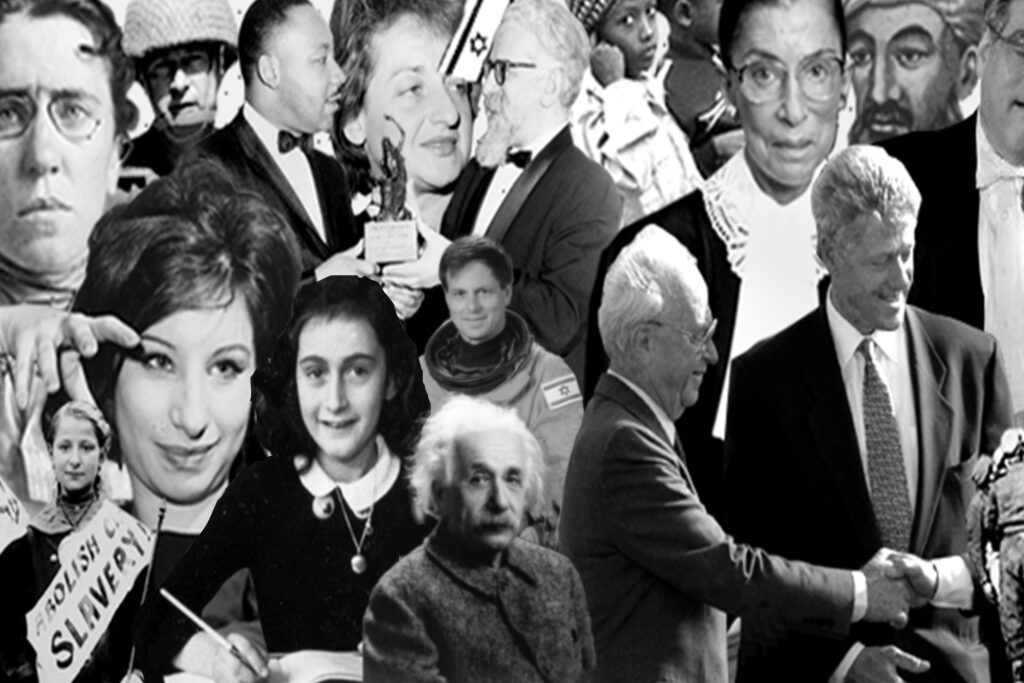
Help ensure Jewish news remains accessible to all. Your donation to the Jewish Telegraphic Agency powers the trusted journalism that has connected Jewish communities worldwide for more than 100 years. With your help, JTA can continue to deliver vital news and insights. Donate today.
